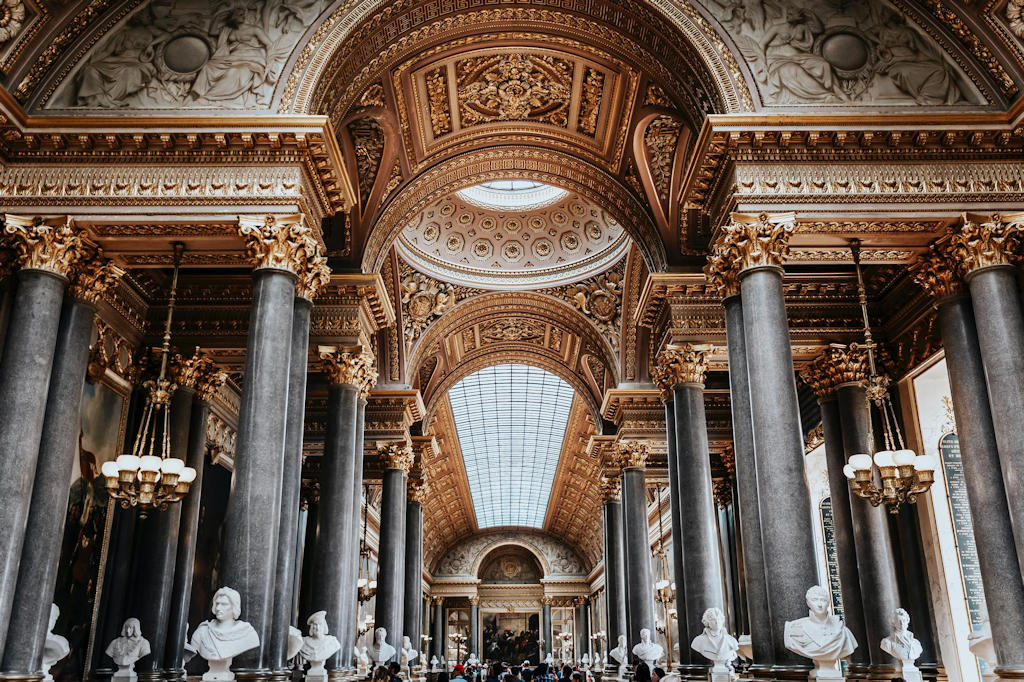Historical Context:
The Baroque period arose during a time of great religious and political shifts in Europe. It coincided with the Counter-Reformation, a movement by the Catholic Church to reassert its influence in response to the Protestant Reformation. The Catholic Church employed art and architecture as powerful tools to convey its message and create emotional impact. Baroque art and architecture became the visual manifestation of this renewed Catholic fervor and were enthusiastically embraced by monarchs and nobility across Europe.Key Characteristics of Baroque Art and Architecture:
- Dramatic and Emotional Expression: Baroque art sought to evoke strong emotions in viewers. It often depicted intense scenes with dynamic compositions, dramatic lighting, and exaggerated gestures. Paintings and sculptures aimed to elicit emotional responses, whether it be awe, reverence, or empathy.
- Illusion and Movement: Baroque artists mastered the use of light and shadow to create a sense of depth and three-dimensionality in their works. They employed techniques such as chiaroscuro, tenebrism, and sfumato to enhance the illusion of movement and to give the impression that figures were coming to life.
- Ornate and Opulent Detail: Baroque art and architecture embraced ornamentation and elaborate detail. Rich textures, intricate patterns, and intricate embellishments adorned paintings, sculptures, and architectural elements. The use of gold leaf, vibrant colors, and luxurious materials added to the overall opulence and grandeur.
- Theatricality and Dynamism: Baroque art and architecture often featured dramatic and dynamic compositions. Figures were depicted in twisted or contorted poses, capturing moments of action or intense emotion. Architecture employed sweeping curves, undulating lines, and dramatic spatial arrangements to create a sense of movement and energy.
Lisbon.vip Recommends
Notable Examples of Baroque Art and Architecture in Portugal:
- Mafra National Palace (Palácio Nacional de Mafra): Located in Mafra, the Mafra National Palace is a monumental Baroque palace and monastery. Built in the 18th century, it serves as a symbol of Portuguese grandeur and religious devotion. The palace features a massive facade adorned with sculptures and intricate details. Its lavish interiors, including the library with its thousands of books, showcase the opulence and artistic richness of the Baroque style.
- Clérigos Church and Tower (Igreja dos Clérigos): Situated in Porto, the Clérigos Church and Tower is an iconic Baroque structure designed by the Italian architect Nicolau Nasoni. The church's facade is characterized by ornate carvings and decorative elements, while the tower provides panoramic views of the city. The intricate details and architectural beauty of the Clérigos Church and Tower make it one of Porto's most recognizable landmarks.
- Bom Jesus do Monte Sanctuary: Located near Braga, the Bom Jesus do Monte Sanctuary is a magnificent example of Baroque architecture. Perched on a hill, the sanctuary features a grand staircase composed of multiple flights adorned with fountains, sculptures, and chapels. At the top, a stunning church awaits, offering visitors a breathtaking view of the surroundings. The Bom Jesus do Monte Sanctuary represents the dramatic and awe-inspiring nature of Baroque design.
- São Francisco Church (Igreja de São Francisco): Found in Porto, the São Francisco Church is an extraordinary testament to Baroque architecture. While the exterior appears relatively simple, the interior is a true marvel. The church's interior is adorned with intricate gilded woodwork, elaborate altarpieces, and intricate tile panels, creating a sumptuous and visually stunning space.
- Palácio Nacional de Queluz: Situated in Queluz, near Lisbon, the Palace of Queluz combines Baroque, Rococo, and Neoclassical elements. Originally a summer residence for the Portuguese royal family, it boasts ornate facades, beautifully landscaped gardens, and exquisitely decorated rooms. The Palace's ballroom, adorned with frescoes, mirrors, and crystal chandeliers, is a standout example of the opulence and elegance of the Baroque era.
Legacy and Influence:
Baroque art and architecture had a lasting impact on subsequent artistic movements. It paved the way for the Rococo style, which further emphasized ornamentation and delicate details. Additionally, elements of the Baroque aesthetic can be seen in later architectural styles, such as Neoclassicism and even Art Nouveau, which incorporated dynamic lines and theatrical elements.The grandeur and drama of Baroque art and architecture continue to captivate audiences today. Many Baroque buildings and artworks have been preserved and are celebrated as cultural treasures. Visitors to places like Rome, Vienna, and Prague can still marvel at the magnificent Baroque structures that have stood the test of time.
Baroque art and architecture represent a visually stunning and emotionally evocative period in European history. It reflects the religious, political, and cultural dynamics of the time, and its legacy can still be felt in the magnificent structures and masterpieces that survive to this day. The Baroque style's emphasis on theatricality, opulence, and dynamic expressions continues to inspire and captivate viewers, reminding us of the enduring power of art to elicit profound emotions and create lasting impressions.



